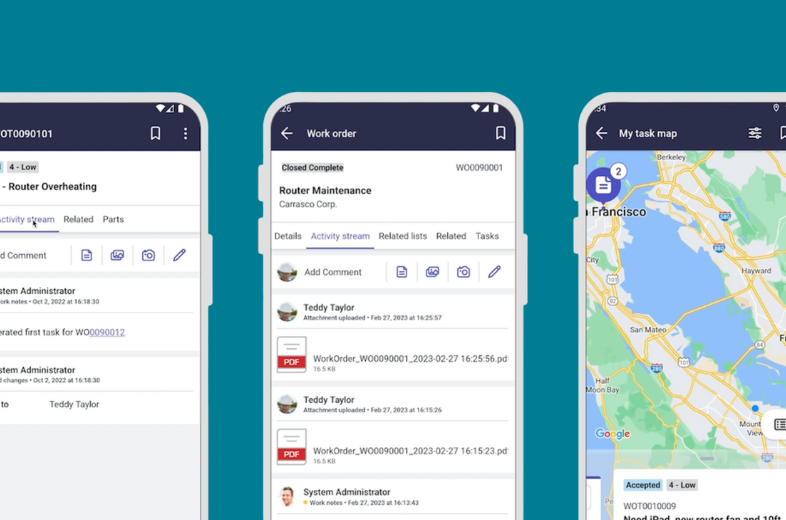Salesforce Winter ’21 Release Highlights

Published Date
What Field Service Users Want to Know
With the release of Winter ’21 comes a long list of exciting features to improve organizations in across all industries, but we’re naturally, focusing on the field service industry. With COVID-19 greatly affecting companies throughout the world, the service industry has been a pivotal component for companies to continue to move forward. Salesforce has recognized the need for enhancements to help meet the problems companies are facing throughout this strenuous time.
Note: Field Service Lightning [FSL) will be rebranded as Salesforce Field Service [SFSJ with this release.
Record Product Warranties
Throughout our years working with organizations in the field service industry, we have seen the importance and impact that a successful warranty system can have within a company. Salesforce is taking a big step into improving their current warranty capability.
Here’s What’s New:
Technicians and mobile workers will have a larger hand within the warranty practice. Mobile workers are gaining the access to view all warranty details, as well as creating claims on the job, ultimately speeding up the claims process. Additionally, as Assets are installed and created for a customer, mobile workers will able to create and attach warranties to the asset upon installment or repair
Why It’s Awesome:
Customers who purchase a warranty are doing so in the trust that it will protect their a.set in borh a timely and cost-efficient manner. When a claim is processed quickly, the customer is seeing the value of their dollar and will be more likely to renew the warranty contract in the future.
Why Bolt Data?
Bolt Data has implemented successful warranty engines for many our customers. Through this time, we’ve seen how an effective warranty process can help the service industry become a profit area for a business. When customers are seeing the return value of a warranty through the repairs, they are more likely to continue to retain the warranty contracts, increasing sales and profitability.
Maintenance with Advanced Recurrence
Routine maintenance is a common occurrence in the field industry world. Customers expect their products to be in working condition as much as possible. One way to achieve this goal is through routine maintenance scheduling. The ability to perform appropriate maintenance on assets will be improved with Winter ’21
Here’s What’s New:
Multiple maintenance schedules can be set up and configured to interact with each other within the same asset. With this set up, a work order will be auto generated, and the technician will know exactly what to do when arriving on site
Why It’s Awesome:
Let’s say an asset has a semi-annual and an annual maintenance contract. This means there will be a time once a year where two maintenance work orders will be scheduled around the same time. Asset Up-time would be disrupted twice now within a short time frame to accommodate for both maintenance service appointments. With Winter ’21 setup, the system will recognize both maintenance work orders and ask the technician to complete the tasks during the same service appointment
Why Bolt Data?
Much like with maintenance contracts, a large portion of Bolt’s clients regularly implement recurring work order creation to handle routine maintenance contracts. It is important to maximize the effectiveness of the time that technicians are at a customer’s site, and to minimize the number of trips a tech has to conduct. Bolt understands the dynamics of creating a dispatch system to have the most efficient time usage for each technician.
Target Work Priorities Using Service Appointments
Companies can have a large number of customers which means that there is a large number of assets or products to maintain and repair. When combining the amount of service appointments needed with the amount of technicians available, many companies get in trouble deciding who, when, and where a tech should be dispatched. With this enhancement. dispatchers will now receive more help in scheduling the finite technicians to the important calls first and the lower priority calls later.
Here’s What’s New:
Custom formulas can now be used to help prioritize which service appointments are the most important. These formula fields can interact directly with the optimizer to ensure that the high priority items are getting service first.
Why It’s Awesome:
Let’s imagine a technician’s calendar. It will be full of high priority, medium priority, and low priority appointments. But, there are times where service appointments exist that are critical and do nor appear on any tech’s calendar; this is the problem. By creating the applicable formula field (say based on due date), the optimizer ensure that the appointment is on a calendar over a less pressing matter. If needed, it will even bump the lower priority appointment to a later date.
Why Bolt Data?
Since working in the realm of field service for the last 7 years, with some members even longer, this has been a common demand and requirement since optimizations have existed. Before, there was no real way to do so and Bolt would implement our own solutions to help solve it. With the help of these engines and updates, we’re positive we can do so faster and more accurately.
Amp Up Sales Cloud with Voice
Service doesn’t just include those who go out and fix assets, perform routine maintenance, or handle installations; it also includes those at the beginning of the service appointment – the call center agents. Winter ’21 provides Voice; an intelligent native telephony system.
Why It’s Awesome:
Voice will provide real-time call transcripts and tie into the digital channels that your agents already use. From these transcripts, Salesforce has now built in an Einstein Next Best Action component to work with the Actions and Recommendations component to help agents with a variety of call change events.
Why Bolt Data?
Simply put: Bolt Data knows service. We have worked heavily on the dispatch side or the service world for years and have come to learn the array of issues that can lead to a Service Appointment being required. We are excited to continue to help clients make the connection between the case management all the way through the completion of t he service appointment.
Einstein Recommendation Builder
In the last few years, Analytics and Automatic Al have been an ever improving force Tn the technology world. Salesforce is taking these ideas and improving their own with every new release. Winter ’21 comes with a recommendation builder. While the builder works for all objects and builds, it is also especially functional within the realm of Field Service
Why It’s Awesome:
This feature can be used to connect different objects to each other, and then provide recommendations on specific criteria. In other words, Assets and products can be tied together to help assist technicians with the correct tools and consumables to get a job done. When technicians arrive with the necessary items to get the job done the first time, their time is now free to move to the next appointment with a happy customer behind them.
Salesforce’s organizational impact leaves no department untouched, and the amount of information can be overwhelming at times. We hope the updates we’ve distilled here today help paint a clearer picture of what to expect, but if you’re curious about diving deeper into any (or all) of the above and exploring their impact on your organization, we’re happy to help. Bolt has a great track record of helping the service side of companies: 25% increase in service revenue, 23% technician productivity increase and 22% workforce utilization increase, for example. We understand that first time fix rate is a major KPI that can help drive a more efficient service program. With this latest Salesforce update, doing so has become even easier.




